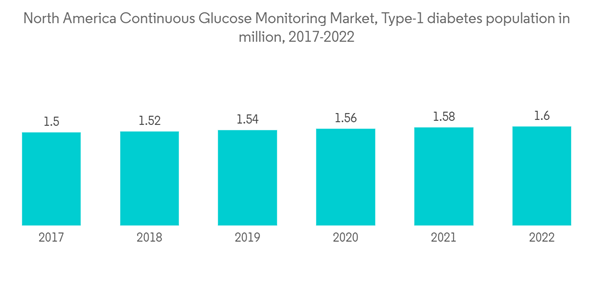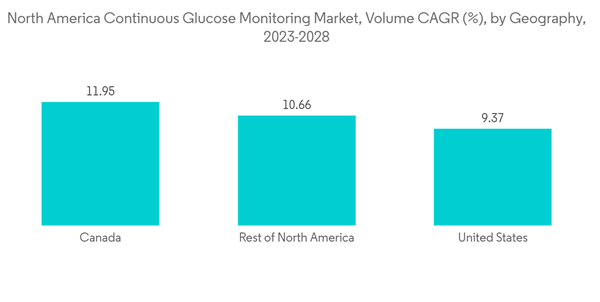The market is estimated to reach a value of USD 5.8 billion by 2027.
The COVID-19 pandemic positively impacted the Continuous glucose monitoring system market growth in the North American region. Patients with diabetes infected with SARS-CoV-2 experience additional stress and increased secretion of hyperglycemic hormones, which results in elevated blood glucose, abnormal glucose variability, and diabetic complications. To avoid aggravation, a patient's blood glucose monitoring should be considered during the COVID-19 patient's hospitalization which has underlined the importance of continuous glucose monitoring devices.
In North America, till April 2022, the United States is having the highest COVID cases with 82 million, the country also registered the highest death rate. According to the Diabetes Voice article published in May 2020, close to 40,000 deaths of people who are having diabetes. The US Food and Drug Administration has also allowed the use of personal blood glucose meters and continuous glucose monitoring devices in hospitals for the duration of the pandemic. Pandemic emergency has created a rise in remote care from both patients and providers and removed many long-standing regulatory barriers. Thus, the COVID-19 outbreak increased the continuous glucose monitoring device market's growth.
The North American region had witnessed an alarming increase in the prevalence of diabetes, in recent years. In developed countries, such as the United States and Canada, the rate of diabetes is at an all-time high, mainly due to lifestyle changes. Diabetes is associated with many health complications. Patients with diabetes require many corrections throughout the day for maintaining nominal blood glucose levels, such as the administration of additional insulin or ingestion of additional carbohydrates by monitoring their blood glucose levels. Therefore, due to an increase in the usage of continuous monitoring devices among the diabetes population the market is expected to grow.
Owing to the aforementioned factors the studied market is anticipated to witness growth over the analysis period.
North America CGM Market Trends
The sensors segment held the highest market share in the current year
The sensors segment held the highest market share of about 69.1% in the current year.To use a CGM, a small sensor is inserted into the abdomen or arm with a tiny plastic tube known as a cannula penetrating the top layer of skin. An adhesive patch holds the sensor in place, allowing it to take glucose readings in interstitial fluid throughout the day and night. Generally, the sensors must be replaced every 7 to 14 days. A small, reusable transmitter connected to the sensor allows the system to send real-time readings wirelessly to a monitor device that displays blood glucose data. Some systems have a dedicated monitor, and some display the information via a smartphone app.
CGM sensors have proven to be effective for patients with frequent hypoglycemic events, sensor-augmented pumps, and gestational diabetes, treated with either continuous subcutaneous insulin infusion or a multiple daily injections insulin regimen. The market players are adopting various ways to increase market share. For instance, to lower the cost burden of diabetic patients in the United States, Abbott, in May 2022, introduced a new, lower-priced category with Libre at around USD 75 to USD 150 each month (2 sensors that last 14 days each).
Researchers are trying to find and develop alternatives to electrochemical-based glucose sensors and create more affordable, minimally invasive, and user-friendly CGM sensors. Optical measurement is a promising platform for glucose sensing. Some technologies with high potential in continuous glucose sensing have been reported, including spectroscopy, fluorescence, holographic technology, etc. Eversense, a CGM sensor based on fluorescence sensing developed by Senseonics Company, presents a much longer lifespan than electrochemical sensors.
Owing to the factors above, the growth of the studied market is anticipated in the North America Region.
The United States held the highest market share in the current year
The United States held the largest share of about 92.1% in the continuous glucose monitoring market in the North American region.The Centers for Disease Control and Prevention (CDC) National Diabetes Statistics Report 2022 estimated that more than 130 million adults live with diabetes or prediabetes in the United States. Type 2 diabetes is more common, and diabetes is more consequential among communities of color; those who live in rural areas; and those with less education, lower incomes, and lower health literacy.
The frequency of monitoring glucose levels depends on the type of diabetes, which varies from patient to patient. Type-1 diabetic patients need to check their blood glucose levels regularly to monitor their blood glucose levels and adjust the insulin dosing accordingly. CGMs allow for improved glucose control because patients can see their glucose levels in real-time without the burden of performing a fingerstick. Using CGMs can eliminate the need for fingerstick blood glucose monitoring. The use of CGM by Type-1 diabetic patients is very less as compared to Type-2 diabetic patients. But the expenditure of Type-1 diabetic patients on these devices is nearly double that of Type-2 diabetics. However, high costs and uncertainties about their efficacy and necessity have kept CGM from being widely used by people with Type-2 diabetes.
Furthermore, the current continuous glucose monitoring devices can either retrospectively display the trends in blood glucose levels by downloading the data or give a real-time picture of glucose levels through receiver displays. The newest CGM models, the Abbott Freestyle Libre 3 and the Dexcom G7, overcame many technical barriers. Technological advances such as Eversense E3 CGMs have significantly improved the ability of providers to treat diabetes and for patients to manage their blood glucose levels.
According to the Centre for Health Care Strategies for Medicaid agencies that can cover and increase access to CGMs for their beneficiaries and the larger healthcare system, there is strong evidence that supports the benefits of CGM use for all people who are insulin-treated with an insulin pump or multiple daily insulin injections, and emerging evidence is showing the benefit of CGMs in patients on basal insulin.
Therefore, owing to the factors above, the growth of the studied market is anticipated in the North America Region.
North America CGM Industry Overview
The North America Continuous Glucose Monitoring Market is consolidated, with few major manufacturers in the market. The CGM devices market is dominated by major players like Dexcom, Medtronic, Abbott, and Senseonics. The measures taken by the market players may ensure a competitive marketplace, forcing the companies to experiment with more new technologies to achieve uniqueness in their products.Additional Benefits:
- The market estimate (ME) sheet in Excel format
- 3 months of analyst support
This product will be delivered within 2 business days.
Table of Contents
Companies Mentioned (Partial List)
A selection of companies mentioned in this report includes, but is not limited to:
- Abbott
- Dexcom
- Medtronic
- Senseonics
- Ascensia
Methodology

LOADING...










